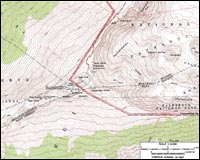|
OCEANIA MAP Mauna Kea Mauna Loa Haleakala Puncak Jaya (Mt Carstensz) Tongariro Ngauruhoe Ruapehu Taranaki (Mount Egmont) Aoraki (Mount Cook) ANTARCTICA MAP |
 | Snow on the summit of Haleakala (National Park Service photo) |
Haleakala
10023 ft (3055 m) . |
||
| Location: | Eastern part of island of Maui, Hawaii | ||
| Lat / Long: | 20.7° N, 156.3° W | ||
| Volcanic Type: | Shield volcano | ||
| Volcanic Status: | Active, last eruption 1790 | ||
| First Ascent: | Native Hawaiian | ||
| First Ski Descent: | |||
| Skiable Vertical: | ? | ||
| Administration: | Haleakala National Park (partial) and Mauna Loa / Kalapala Forest Reserves (State of Hawaii) | ||
| Haleakala is the third highest volcano in Hawaii, another huge shield volcano which forms the eastern part of the dumbbell-shaped island of Maui. Haleakala (meaning "House of the Sun") properly refers to the large crater east of the summit, which was actually formed not by volcanic eruption but by erosion, and the volcano itself is often called East Maui by volcanologists. A prominent cinder cone, Red Hill, on the rim of this crater forms the true summit of the mountain, and a paved road leads to the top. Numerous other cinder cones and lava flows are found in the crater, along with rare and remarkable plants such as the Haleakala silversword. Snow now falls quite rarely on Haleakala, apparently it had been 10 years since the previous snowfall when the last major snow occurred in January 2002, which melted within two days. Any skiing or snowboarding must be done with extreme caution, since with the very shallow snowpack it would be easy not only to injure oneself but also to severely damage the fragile plants and terrain of the summit area. | |||

